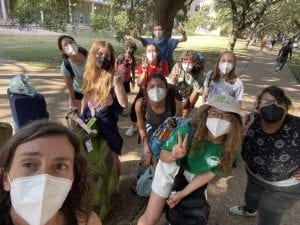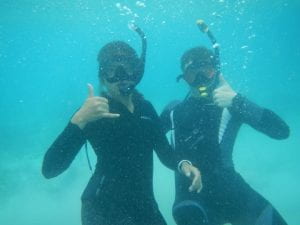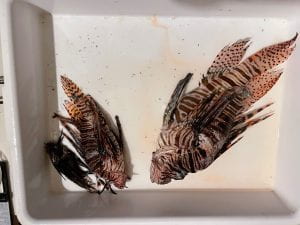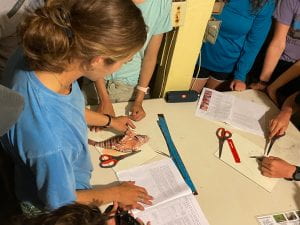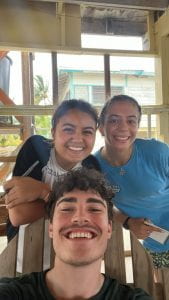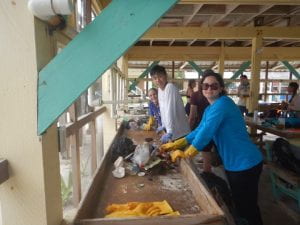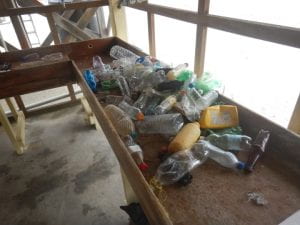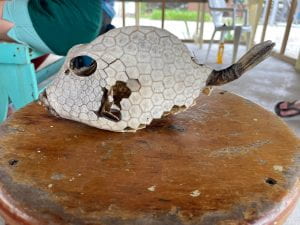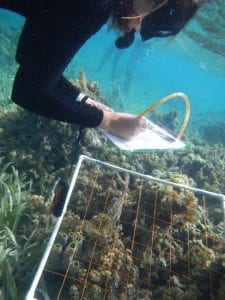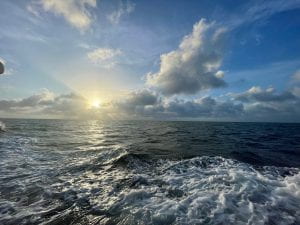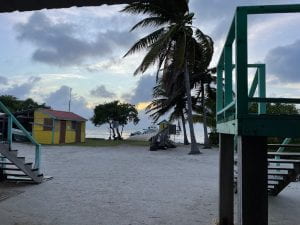Tag Archives: Red Algae
Day 7: Sea Ya Later Glover’s
Our last full day at Glover’s 🙁 We started it off with our last data collection for Sunday’s research question about coral cover and sea urchin abundance at a non-MPA site. This was pretty quick as we have all become really efficient with our methods and were even able to collect 177 (!!!) sea urchins, all Echinometra viridis. It was pretty sad how dead this reef was but I still saw an Amber Pinshell mollusk and some Common Sea Fan. We were also able to go to a protected area where there were so many different reef fish and I got to dive down a lot to observe them closer. The water was pretty rough but it made it all the more fun! I saw lots of Branching Vase Sponge, saucer leaf brown algae, Jania spp. and Amphiora fragilissima red algae, a parrot fish, more French Angel Fish, a puffer, and some stag horn coral! Also, Dr. Solomon secured us our third lion fish of the trip, a small but the perfect addition for our collection.
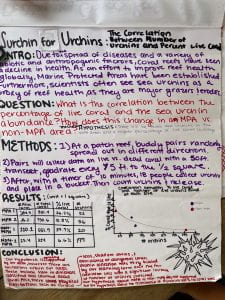
After finishing up our poster for the experiment, we had a few topic lectures so we would have more time for the lion fish ceviche!! After dinner, we gathered in the wet lab and first dissected the fish. We had three different sized ones: Snack, Appetizer, and Main Course. This was of course based on their sizes, and I got to work on Main Course, and it was hugeeee. We first took the 680g (!!) fish and measured the gape width and length which was about 3 cm and 3.25 cm respectively. Then, we sexed it and found out that it was a male before cutting open it’s stomach to see what was inside. It had these two little pieces that were pretty digested but we think it may have been some kind of invertebrate. It was super cool to be able to analyze the food that we were about to eat, especially something that is harmful to our environment. After all the fish were gutted and cleaned, Dr. Solomon made it into a delicious ceviche that we enjoyed with some plantain and corn chips. Highly recommend, 12/10 experience and a great way to end the first part of our trip.
– Sophia
Day 6: One Man’s Trash.. Is Still Trash…
Even though the weather has been kind of windy and almost stormy recently, we decided to explore the fore-reef this morning! The water outside the atoll was choppier than usual but that’s what made it fun. I swear my gear hates me as my fin buckle broke (but Dr. Correa fixed it in true marine biologist fashion with some capo ties), and then as I was jumping in, my snorkel became detached from my mask and I had to dive down to grab it… As we were in the water, the swells were soothing and it was amazing to look at the drop-off of the slope. Here, there was so much coral growth and even a Green Sea Turtle! We also saw lots of Comb Jellies and some unidentified blue fish (possibly parrotfish?). No specific red algae sightings as we were too far up to exactly see anything but I am sure there was plenty on the sea floor below. Because of the weather and character of the waves, we sadly were only in the fore-reef for about 30 or so minutes. However, I am now super motivated to try to get scuba certified so I could explore more cool places like it for deeper depths and longer periods of time!!
After lunch we then began our next experiment, taking a break from our reef experiment, we began a new one that was about picking up trash and cleaning the shore line of the Middle Caye. We were trying to figure out how much of the trash would have to be transported to shore and how much could be burned. Before we began, Nate gave a presentation about marine debris and all of the different sources of trash (80% of which is from land based sources) and learned about the Gulf of Honduras Gyre that is a current that circulates the trash around and pushes it towards Glover’s Cayes. As Elena and I were cleaning up a small ~ 30 square foot area in only 30 minutes, we were able to pick up 28.7kg of trash… and it didn’t even look like we made a dent in it. With everyone’s combined efforts in three different areas, we were able to collect a total of 64.54kg of trash within an hour. Absolutely insane. Also, because of transportation issues, Grover’s has to burn all of the trash (except for glass and metal) because there is simply too much trash for them to transfer to landfills with the amount of boats that they have/logistics. As we were sorting the trash, we went through so many everyday items that it really made you start thinking about what products you consume/use and how they are packaged. I now am super interested in beach clean up as it is a direct way to help our ocean and maybe even join Rice’s Beach Cleanup group. (Also someone found a super cool mummified box fish !!!)
After some music to pick up our energy while sorting trash, making a poster and presenting it, we had some free time before and after dinner. After dinner, one of our marine safety officers, Ruth, explained some of Belize’s history which is so interesting. There are only 400,000 people in Belize and it’s about the size of Massachusetts but it has such a diverse population. There are foods and languages from all different cultures: Indian, Chinese, Kriol, British, Mestizo, etc, it sounds amazing. I think she has convinced all of us that Belize has a lot to offer and that we all need to visit more 😉
– Sophia
Day 5: Sea Eggs, Sea Stars, and Spines Oh My!!
After waking up with even more sand fly and mosquito bites on my legs, we went out to go to carry out some more TFB shenanigans. Continuing data collection for yesterday’s research question, we went out to two Marine Protected Areas to measure the dead vs alive coral found. It was beautiful as always (even though there was a significant amount of dead coral covered in macro-algae and disease…), and we collected sooo many urchin – 108 total between the two areas! There were also a ton of different echinoderms in the second MPA: lots and lots of Brittle Sea Stars, a Sea Biscuit, and a West Indian Sea Egg. Other people also saw some tunicates (aka Sea Squirts aka one of my taxon identifications) that were a blue-ish color!! I was also able to identify three different red algae throughout the day: Jania spp., Galaxuara spp., and lastly Amphiora fragilissima. It’s been really fun trying to see where they might show up and how they might vary depending on their location.
We then had some free time after lunch to work on our field notebooks until 4pm when we went out on an optional snorkel to explore the nearby reef crest. We snorkeled by the area that is after the absorption of the wave energy and got to see what happens with an exchange of the cold ocean water into the warm water of the Caye and a creation of drastic fluctuating temperature differences. Here, it was very much a macro-algae dominated area (tons of sargassum, Mermaid’s Fan, Amphiora fragilissima, white scroll brown algae, Mermaid’s Cup) and much of the coral was dead.

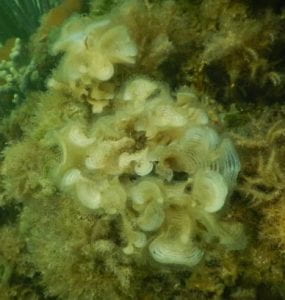
However, Dr. Correa was explaining that the groups of coral coral that were alive must be pretty resilient and are the coral that researchers are looking into to understand as to why/how they are able to survive these extremes. They can then take this information and apply it to other coral (genetically evolve them, etc.) to try to make them more resilient to drastic temperature changes and hopefully save more corals from climate change.
For the rest of the night after dinner we were lucky enough to have two guest speakers: one from the Belize Fisheries Department and one from the Belizean Coast Guard. They informed us on their roles within Belizean waters and within Glover’s atoll, especially with illegal fishing, enforcement of marine laws, and protecting the reefs. They all play such an important role in preserving the reefs and educating fishermen as to how they can continue their livelihood but in a sustainable way. Hopefully so both parties can coexist with a positive outcome and many sustainable habits that will help these waters stay as healthy for as long as they can.
– Sophia
Day 4: A Field Aquarium
Starting a new experiment today, the group came up with the research question “What is the correlation between the percentage of live coral and the sea urchin prevalence? How does this change in a protected versus unprotected zone?” We will be collecting data for this experiment over the next couple days, starting with today. After coming up with the experiment layout, we had some extra time before lunch so we went to the shallower sea grass area on the North side of the island to try to collect as many organisms as we could find into buckets. We were able to find conch, mantis shrimp, a lobster, a Diadima antillarum (a venomous urchin), corallomorphs, anemone, and even some Crustose Corralline red algae! One cool fact that I learned today is that spiny lobsters don’t have claws, unlike the ones that we see in the US. It was like our own little aquarium (which releases the animals back into the ocean of course).
After lunch, we went out on the boat to begin collecting our data. We first went to a patch we went to wasn’t a Marine Protected Area and was pretty shallow. Here, there was a lot of coral rubble and diseased coral, and it was pretty difficult to keep still with the current. To estimate the number of sea urchins in the area, we were all given 10 minutes to collect as many as we could. I was able to find a couple, but they were both underneath rocks that I couldn’t break. We ended up finding 20 different urchins! Also Dr. Correa picked up some Galaxuara spp. (a red algae) that was actually all over the sea floor. We then moved onto a MPA and got to snorkel around, just to explore. There was a huge difference in the landscape (obviously there were topography factors involved in the difference but still) with an abundance of health coral, super diverse grouping of fish and coral, and it was absolutely stunning. Here, I was even able to identify Jania spp. (a red algae) which was actually everywhere throughout the reef. I also was able to identify Fire Coral, Sergeant Fish, Dusky Damsel Fish, French Angel Fish (maybe one of my favorites now), White Scroll Algae, Boulder Star Coral, and Whitestar Sheet Coral. AND Dr. Solomon was able to spear a Lion Fish so we will be making that into some delicious Lion Fish ceviche tomorrow or so!!
– Sophia
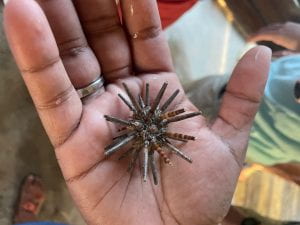
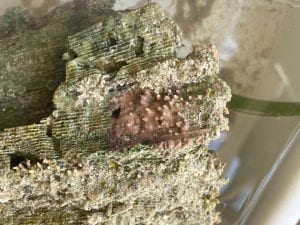
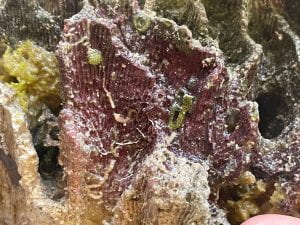
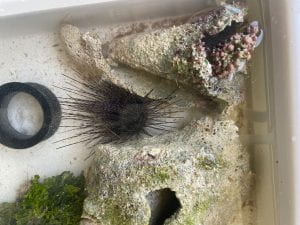
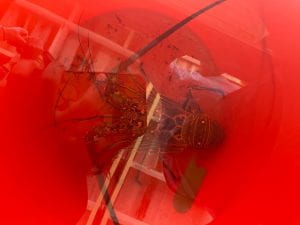
Day 3: A Coconut Paradise
Feeling like a true field biologist! Today we practiced using our quadrates and trisects, first on land and then in the water. For the water experiment, the whole group came up with the research question: how does the density of the green algae Penicillus changes the further you go from shore? We also brainstormed a hypothesis (that they’d become less abundant) and a method to carry out our question. In the end, our hypothesis was wrong, but it was still really fun to be able to look closer into the seagrass and find all of the other organisms that reside in it (corallomorphs, anemones, and conchs).
Before, as we were working on our experiments and waiting for everyone to be finished, we were all treated with 10/10 service from Dr. Correa and Dr. Solomon’s kids Calliou and Nayala. I learned how to husk a coconut and also how to get the water out from it. I now believe that I could most definitely survive on a deserted island. No doubt.
After lunch, we went to the wet lab and worked on our group poster about the green algae experiment (during which we were graciously treated with even more delicious fresh coconut from Calliou and Nayala) and then presented it to Dr. Correa and Dr. Solomon (we totally aced it too ;)). We then went out to Dr. Correa’s favorite spot in the whole entire world: the Coral Graveyard. Once you get there, you can totally understand why too. Here, it was a section of the old reef that re-mineralized and all of the coral skeletons are super clear and really easy to identify as they are all now stone. This also includes the conch shells which I thought was pretty crazy. Some corals that we identified include Fire Coral, Symmetrical Brain Coral, and Pillar Coral (which sadly isn’t very common anymore). Also! I was able to see some Crustose Coraline Algae (my taxa) mineralized. It was super cool to be able to see the skeleton of the hundreds of pieces corals before they corrode into sand, something that you don’t get to see everyday.
-Sophia
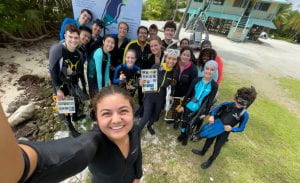
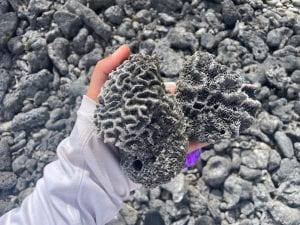
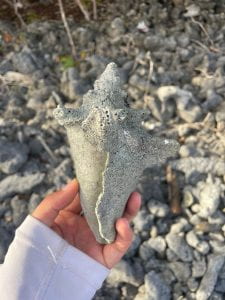

Day 2: Mosquito Magnet
Today started off early with a yummy banana pancake breakfast and then our first snorkel excursion at 8am. We finally got to break out all of our fancy TFB gear (snorkels, masks, fins, diving skins) and use them! To get off of the dock and into the water, I just sat down and shimmied off, directly into a school of small fish. We then swam over some sea grass to a path reef and I was able to see sooo many organisms. There was Brain Coral, Common Sea Fans, Corky Sea Fingers, also lobsters, French Angel Fish, Lion Fish (!!), and an anemone! Apparently we might go out and hunt for Lion Fish since they are invasive and have them for a meal. I also was able to spot a piece of Laurencia spp. floating in the water and a lot of Spryidia filaments on the rocks. I’ll spare you from my extremely blurry photos but I’ll get the hang of this camera soon.
After we got back on land we made one of our field tools called a Quadrate which we will use as a measuring device to collect data. Then after lunch, we headed back into the water but this time through the Mangroves of Death (cue dramatic music). Where does this name come from you ask? The mosquitos. We literally had to run for a few minutes to try to dodge as many mosquitos as we can in order to go through the mangroves. It was totally worth it though. We made it to the shoreline and had to “stingray shuffle” through the seagrass because it’s their favorite habitat and you want to avoid surprising them. At these patch reefs I saw Yellow Snapper, baby Blue Tang (which look just like yellow surgeon fish), Royal Gramma (shout out to my dad’s fish tank), damselfish, a sea urchin (super cool), and similar coral as the patch reef from earlier in the day.
We chose to swim back in order to avoid the MOD once again, and saw even more cool things – sharks, sponges, and stingrays (oh my!). It was actually very nice to have more time in the water and watching the sea grass was quite meditative.
For the rest of the day we had taxon briefing and a topic lecture which will all help with more identification tomorrow!
-Sophia
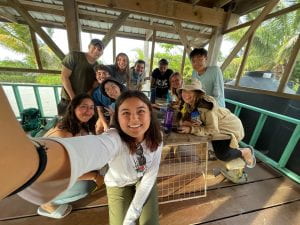
Day 1: An Ocean Rollercoaster
First official day of the trip completed! After a slightly hectic beginning at the airport, including me losing my credit card (… sorry Dad…), we were all able to make it onto our three hour flight into Belize. Riding in two vans to get to the dock for our boat to Glover’s Reef Research Station, we stopped by a small supermarket to grab some snacks to bring onto the island. My haul included Doritos, plantain chips (even after a whole semester’s worth, I will never be sick of them), and some yummy Melacotón juice.
Afterwards, we made it to the dock where we had lunch and loaded up the boat. The boat ride was about 4 hours and a literal roller coaster. Once we broke the reef barrier and made it into the open ocean after an hour or so, the “small” swells (according to one of the crew) were big enough to make us catch some air – and it was SO. FUN. Apparently the swells can get up to 20 feet and I am okay with not experiencing them. During this long boat ride, I was able to take a nap, see some beautiful ocean (sadly no sightings of Red Algae or tunicates but I am determined I will find them), learn about Belizean culture, and even learn some Kriol/English Creole (I’m totally going to be fluent at the end of the week just wait)!
When we made it to the Caye, we brought our stuff up into our bunks and had some free time before dinner. All of the commodities here are sustainable: composting toilets, rainwater showers, and open windows for natural air-conditioning. There are also SO many crabs. Hermit crabs and what I believe to be the Common Land Crab are literally everywhere. Someone mentioned that they are like the squirrels at Rice and I couldn’t describe it better. So many crab jumpscares. For dinner we ate delicious coconut rice and chicken, with the best mango I have ever had for dessert.
I am about to have the best sleep of my life – goodnight!!
-Sophia
The Pre-Departure Anticipation!!
Hello there! My name is Sophia Figueroa and welcome to our Belize Blog!!
The day is finally here! Tomorrow we are officially leaving for Belize and I absolutely cannot wait. It’s so crazy to me that it’s already time for the trip as summer feels like it has moved so quickly. The build up to the actual trip is always the most nerve wracking, with lots of questions filling in my brain about all of the different possibilities of what I might come across. In all honesty, I think this is the worst part about trips but I know that as soon as I meet up with everyone on Wednesday, it’ll all go away.
I’ve been packing for the last week or so, and after putting the last few items in my bag, I realized that this is really happening! I’ve been working on my taxonomic lectures and topic lecture for the past month, reading lots of different journal articles and researching for hours on end about Red Algae, Tunicates, and biodiversity in cave systems. I expect this trip to be pretty intense with lots of lectures and presentations that everyone has been working hard on; but I’m also excited to see and learn about everyone else’s research. I expect to gain many different skills while on this trip, both from the lectures and also from the on-hands experience of being out in the field. I believe that there’s no better way to solidify what you learn in the classroom than going out and applying it in real life. I’m really excited to go to a new country and environment and be able to understand more about what being a field biologist looks like with people who share the same excitement of EEB as I do. While I’m obviously excited for the hands-on work we are going to be doing, I’m also really excited to get to know everyone and make new friends (cheesy I know, I’m sorry).
I think the main thing I’m nervous about is that I may not be able to identify many things from my taxonomic groups. I know that after a while, I’ll be able to recognize more species, and I recognize that it’s impossible to put all of the common species on my taxa cards; but it’s still a little nerve-racking to see if I put enough information on them and to see how many on my card actually appear in the field. I don’t have any experience in doing fieldwork really, I’ve only really worked in a lab setting so I’m very ready to go outside and apply what I know and gain even more knowledge. I’m also trying to mentally prepare myself for the humidity we might face, telling myself it can only be as bad as Houston humidity, but we’ll see… I’m definitely ready to start getting into the swing of things with work, assignments, and getting to know people so that these pre-trip nerves go away!
See you in Belize!
– Sophia
Pre-Departure: Belize here I come!
This morning I got the notification that our flight to Belize is less than 5 days away. I have never been to Belize, and in fact, I have never really been out of the country on a trip like this before, so I am definitely excited. Ah! My first trip to the tropics!
Sitting on my couch watching Blue Planet episodes of the tropics in HD has given me some pretty high standards for the beauty of these places, so I have high hopes for what I might encounter. Also, I totally plan to channel my inner David Attenborough for this trip. However, I am still a little nervous about how it’s going to go.
I am the taxon expert for arachnids and green/red algae. My family thought it would be funny to make me watch the 1990 movie Arachnophobia in preparation for my trip. Let’s just say that I found it…. a little… less funny. I have never really been scared of spiders before, but last night, I had a dream I was attacked by a giant spider, so it is safe to say I am a bit wary.
I have done my best these past few months to ensure that I am prepared for this trip. Aside from the packing and organizing of all the snorkel/rainforest gear, I prepared myself through the taxonomic research, the readings, and the creation of the presentations. I am hoping that I can identify both arachnids and algae in the field. My biggest worry for the trip is that either Dr. Solomon or Dr. Shore is going to ask me about a certain organism and I am going to stare blankly back at them like a deer in headlights. I have my fingers crossed that this won’t be the case! Not to mention, I have had to mentally prepare myself for the humidity we are going to endure. 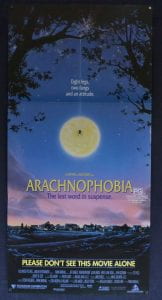 For this trip, I am most excited about experiencing fieldwork for the first time. I have always been limited in learning about the natural world from books, videos, or short field trips, so 14 days in the tropics is something I am looking forward to. It feels like it has been centuries since I first started dreaming about doing fieldwork. Overall, I hope this trip will give me some insight into what a career involving fieldwork might be like, and if this could be a career path for me. I think it will be, but you never know until you try it.
For this trip, I am most excited about experiencing fieldwork for the first time. I have always been limited in learning about the natural world from books, videos, or short field trips, so 14 days in the tropics is something I am looking forward to. It feels like it has been centuries since I first started dreaming about doing fieldwork. Overall, I hope this trip will give me some insight into what a career involving fieldwork might be like, and if this could be a career path for me. I think it will be, but you never know until you try it.
On a final note, I grew up on the Texas coast my whole life which makes me accustomed to one thing: murky ocean water (Thank you Mississippi river sediment!) So, I cannot wait to put my feet into the ocean and be able to see my toes clearly!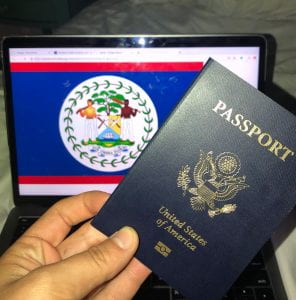
Wish me luck!
-Bella

